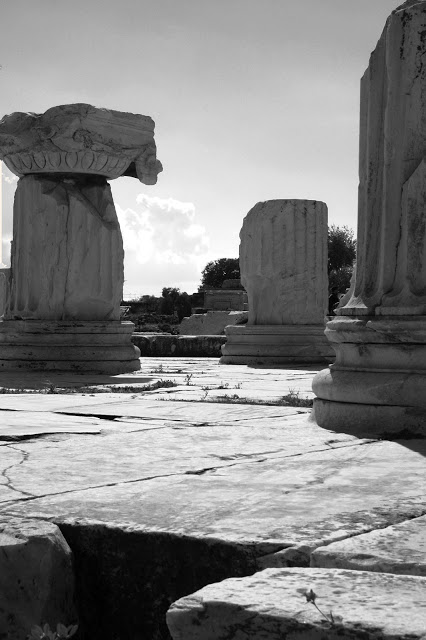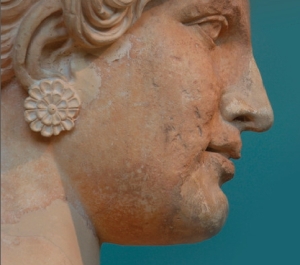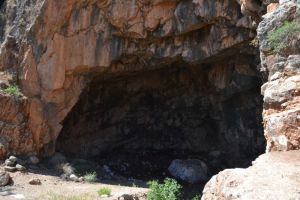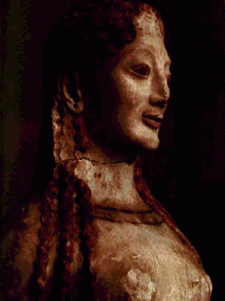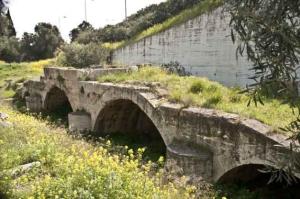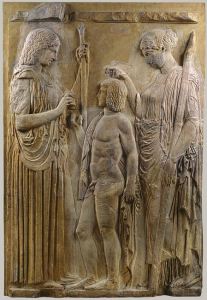Ψ
Prologue : The Myth
Persephone, daughter of Demeter, was playing and picking flowers one day in the fields with the daughters of Oceanus. Unknown to her, but sanctioned by Zeus, Hades, god of the Underworld, was setting a trap for her. She came upon a narcissus, the flower of the Underworld, which was blooming so beautifully that she could not resist reaching out to pluck it. Immediately, the ground split open to allow Hades in his chariot to emerge into the field and abduct the girl. No one heard her cries, except for Hecate and Helios.
Demeter, aware that something had gone wrong, began to search for her daughter, but no one was willing to to tell her what had befallen Persephone. After wandering ten days without nourishment, she met Hecate, who told her that she had heard Persephone’s cry, but had not seen what had transpired. So, the two of them decided to seek out Helios, the watchman of the gods. Helios, pitying Demeter, told her the truth : that Zeus had allowed Hades to kidnap her daughter.
At this news, Demeter fell into deep sadness and removed herself from Olympus, bitter at Zeus. While she was resting at the Well of the Maidens in the town of Eleusis, she encountered the grand-daughters of Eleusis himself, who did not recognize the goddess because she was in disguise. Demeter told them that she was from Crete and had been carried here by pirates and was now looking for employment. In due course, Demeter was hired as the household nurse for the girls’ family and was given the care of their youngest sibling, a boy. Secretly, Demeter fed the boy ambrosia, nectar of the gods, and placed him into a fire each night, slowly turning him into an immortal. Her plan, however, was uncovered by the mother, who thought Demeter was trying to kill the child. In anger, Demeter informed the queen that her son could have become immortal, but now would only live to an old age. Then, the goddess demanded that a temple and altar be built to her on a hill, that she might teach the people of Eleusis her Mysteries.
Part I
Those that took part in the Eleusinian Mysteries were said to be in possession of a secret that was not to be divulged on pain of death, literally: the story goes that two young men were executed for breaking into the sanctuary while the secret ceremony was in process.
Before the multi-layered Mysteries, a pilgrim seeking initiation was a mystes, a person with eyes closed and therefore blind to the truth, afterwards he or she had become an epoptes, one who sees the truth.
The Goddess Demeter was the presiding deity at the sanctuary of Eleusis (together with her daughter, Persephone – and in the background Hekate, in her form as Crone.) First and foremost, She was the Mater Dolorosa, connected with Death and the Afterlife.
Along the narrow, now almost ruined bridge across the brackish water of a swamp, a great number of pilgrims – at its height they came in their thousands ! – made their way in the Autumn to the sacred Temple grounds of Eleusis. The bridge was too narrow for vehicular traffic, and for the pilgrims it was also a ‘crossing’ between worlds, for the region beyond was deemed to have a particular affinity with the realm of the departed spirits.
Part II
Part of the multi-layered myth forming the basis of the Eleusis Mysteries includes the Great Mother, Demeter, disguised as an old woman playing nursemaid to a royal child, whom she intends to immortalise by, quite literally, nightly ‘baptising’ him in fire. [Almost exactly the same incident occurs in the story of Isis, when she too is in hiding, after the murder of Osiris . . .]
The sanctifying and protective power of fire was tended for its magical properties long before its more practical applications – perhaps even in imitation of other forces that early man had seen and, without fully understanding, could only interpret as a kind of fire.
Such traditions are commemorated even into such a relatively late saying as “He who is close to me is close to the Fire”, but similar manifestations go way, way, back – almost to the very beginning in fact.
Part III
ELEUSIS : ENTHEOGENS – OR NOT . . .
For many, it has been a challenge of the ages to ‘solve’ the Eleusinian Mysteries, and over the last half-century-or-so many self-appointed experts have gamely stepped forward with their idea of an answer.
Taking Nietzsche as their starting point, most have alighted upon the kykeon – the potion of barley steeped in water, perhaps with a little mint, consumed after the fast which preceded the Rites – as the key. The assumption, of course, has been that it must have contained some sort of mind-altering substance – the suggested culprit changing over time (to avoid apparent objections and obstacles), from psilocybin to claviceps purpurea, LSD to DMT – even the ‘vine of the soul’ ayahuasca ! – thereby also keeping nimbly in step with ever-changing fashions as psychedelics give way to entheogens . . .
It would seem to be the case that contemporary commentators simply cannot conceive of a meaningful psycho-spiritual experience without the need for an underlying physical cause – as if that would ever ‘explain’ away the Mysteries, anyway.
Part IV
It was never simply one thing only. As time went on – and the Initiations continued for some 2,000 years ! – the legends, the myths at their heart, became more layered. Stories are retold and embroidered along the way; variants are combined, and new characters and events are added in ways that do not always make the greatest sense.
As well as the more obvious story about the crops, the seed, fertility, the life-cycle of the plants and the seasons – the fact that Winter seemed a kind of death : the seeds going into the ground, like the dead, only to return and bring new life or at least the source of new life with the next Spring – there is more.
There is also a kind of ‘family romance’ about shifting roles between Mother and Daughter, as the latter comes of marriageable age. There’s the upheaval for the Mother of apparently losing the Daughter, the way the men of the tribe or family were often complicit in what must have seemed like a theft, if not rape. Then, the reconciliation of the Mother to her Daughter’s new role as a bride and potential mother in her own right. Only after the Mother seeks the advice of the Crone figure and ‘role-plays’ being the older grandmother-like figure herself [Demeter disguised as the old woman], can the reconciliation between Mother and Daughter actually begin.
Wrapped up in the middle of all this there’s a lesson about the continuance of Life beyond this incarnation: that mothers and daughters, fathers, sons, siblings, and lovers, will all be re-united and go on to new forms of Life.
Death is not the end and the eventual reconciliation of Demeter as the Mother, the Source of Life, with Hades, King of the Dead, via her Daughter’s union and the way they end up sharing her, as it were, is a representation of the balancing of these two engines, Death and Life, and the varying roles they each require.
Ψ

